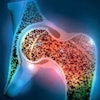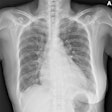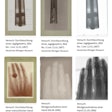
After I wrote recently on this site about the meaning of the term "productivity" in the context of radiology services, a number of people contacted me asking for some practical tips. So here are 10 suggestions on how to improve reporting productivity.
They are a mixed bag -- some apply to individual radiologists, others to service managers. Some have a robust evidence base; others owe more to experience and opinion. Some will cost nothing to implement; others will carry a price tag.
One more caveat at the start: The tips below relate mainly to reporting, which we know accounts for only about 30% to 40% of the work of a hospital-based radiologist. Increasing productivity in intervention, ultrasound, consultation, or clinical meetings is another matter altogether.
1. Protect your reporting time
 Dr. Giles Maskell.
Dr. Giles Maskell.The negative impact of interruptions on radiology reporting has been well documented. Many hospital departments have addressed this by creating a "hot seat" or "radiologist of the day" through which all inquiries can be channeled, freeing other radiologists from distractions as much as possible. For various reasons, I tend to prefer the model of a communal reporting area in the department rather than radiologists reporting in isolated offices, but this model makes it all the more important to manage potential interruptions. The experience of many is that reporting at home -- given suitable technological support -- can produce a measurable increase in reporting output over that which can be achieved in a busy hospital environment.
2. Optimize the reporting environment
Insufficient attention has traditionally been paid to the ergonomics of the environment in which we report. Addressing issues of comfort, ambient light, and noise will not only allow us to report for longer but will also improve the quality of our work.1
3. Take regular breaks
It may seem paradoxical, but taking regular breaks away from the workstation undoubtedly improves productivity. Knowing that I have a break coming up at a certain time will keep me reporting up to that time, and a short planned break is good for our eyes and brains in addressing potential fatigue and also allows us to return with renewed vigor.
4. Make the task manageable
One of the surest ways to reduce the output of a given radiologist or group of radiologists is to set them an impossible task. If I log on and find a worklist containing 20 CT or MRI examinations, all within my competence to report, I will go ahead and report them. If I log on and find 200 exams waiting, I will report a couple and then stop for coffee. Older radiologists will remember the satisfaction of completing the "pile" of plain films -- the sense of achievement that came from the knowledge of a job well done and finished. In the PACS era, with worklists that are constantly replenished, that source of satisfaction can be lost. This can, of course, be alleviated by the active management of worklists rather than presenting radiologists with an insuperable mountain to climb every time. Hospital departments have much to learn from teleradiology companies in this respect.
5. Keep it meaningful
A wealth of evidence in the psychology literature shows that if we perceive a task as meaningful, we will work harder at it than if we don't. Now I'm not going to suggest that any of what we do in radiology is meaningless, but I suspect you would agree that some of what we do is intrinsically more meaningful. For example, reporting inpatient chest x-rays two weeks after the patient has gone home will occasionally throw up a surprise, but how much more meaningful is it to report the study while the patient is still in hospital so that the report could actually affect the patient's current management? Reporting in a timely fashion certainly enhances the meaning in our work, but it is not the only way.
6. Feedback, feedback, feedback
Nothing enhances the meaning in what we do so much as regular feedback. Having the kind of relationship with your surgeon colleague that means that she will phone you after the operation to say what she found in the patient you had discussed with her beforehand -- even when you were right! -- is priceless. The ability to access the operation note later through an electronic record is a poor second but still infinitely better than never knowing the outcome. As radiologists, we have the ability to give feedback to our colleagues all the time when we review subsequent imaging or learn of clinical outcomes. We should do it much more.2
7. Mix it up
Don't get stale! Don't plan to spend an entire morning or afternoon reporting studies of exactly the same kind. Not only will you get bored, but also you will start to miss things and your reporting productivity will reduce.
8. Love your PACS team
Radiology departments depend like no other hospital service on smooth-running IT. The impact of a full-blown "crash" on radiology department productivity is plain to see, but the insidious effects of a poor service -- including difficulties with image transfer between institutions, prolonged times taken for studies to load, and an excess of speech recognition errors -- can be just as damaging, if less dramatic.
9. Choose your colleagues carefully
Colleagues can have a very important effect on how we perform. The presence of some people in the department or reading room will enhance the performance of the whole team, whereas others can have a less positive impact. Reporting at home or in isolation will resolve that for some of us but also means missing out on some positive interactions.
Observant readers will have noted that many of the tips I have offered to improve productivity also feature in recommendations for avoiding error. This is not a coincidence. All of us work best and hardest when we want to do so. The financial rewards will vary from place to place, but the professional rewards are available to all of us and can be just as powerful. A happy team is a productive team, and that is my 10th and final tip for those trying to get the best out of their radiology reporting services.
Dr. Giles Maskell is a radiologist in Truro, U.K. He is past president of the U.K. Royal College of Radiologists. Competing interests: None declared.
References
- Rodrigues JC, Morgan S., Augustine K, et al. Musculoskeletal symptoms amongst clinical radiologists and the implications of reporting environment ergonomics -- a multicentre questionnaire study. J Digital Imaging. 2014;27(2):255-261.
- Royal College of Radiologists. Lifelong learning and building teams using peer feedback. Royal College of Radiologists. https://www.rcr.ac.uk/system/files/publication/field_publication_files/bfcr175_lifelong_learning_building_teams.pdf. Published September 2017.
The comments and observations expressed herein do not necessarily reflect the opinions of AuntMinnieEurope.com, nor should they be construed as an endorsement or admonishment of any particular vendor, analyst, industry consultant, or consulting group.



















